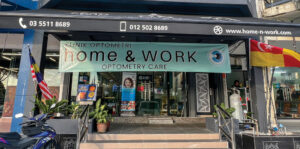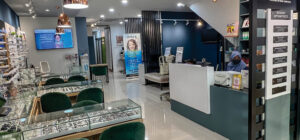Early intervention is key to slowing the progression of myopia in children
Myopia or short-sightedness is a common eye disorder and is the leading cause of visual impairment in children. Growing levels of high myopia increase the risks of severe eye conditions, such as myopic macular degeneration, cataract, glaucoma and retinal detachment, which can lead to permanent blindness.
Myopia is a vision condition in which you can see objects near to you clearly, but objects farther away are blurry. It occurs when the shape of the eyes are too long or the cornea too curve, causes light rays to bend ( refract ) incorrectly, focusing images in front of your retina instead of on your retina.
According to the Brien Holden Vision Institute report in 2016, half the world’s population, nearly five billion, will be myopic by 2050. And if the current trends continue, up to one-fifth of them are at a significantly increased risk of blindness.

Optometrist and Founder of Home & Work Optometry Care Sdn. Bhd., Liew Mei Lin, actively advocates for myopia prevention, especially among children.
“During this pandemic, our practice has been actively advocating myopia care and prevention by educating parents on the importance of myopia control. And once optometry practices were allowed to operate, we were quick to recover and ready to serve the public, especially in addressing the issue of myopia progression.”
Liew, who has been practising for 25 years, specialises in myopia management and control for children.
“We are a primary eye provider, where we screen for eye diseases apart from prescribing corrective glasses or contact lenses for any age group.
“We also provide sessions of vision therapy and exercises to children with visual problems such as squint and lazy eye.
“Apart from that, we conduct eye health examination and prescribe safety glasses to the working groups. In general, we provide Optometry Care for people at home and also at work. That’s how our practice’s name, Home & Work Optometry Care, came about.”
 Early detection and prevention of myopia
Early detection and prevention of myopia
During this pandemic, most activities were confined indoors. Children, adults, and the elderly spent more time on digital devices.
“At one point, for most school children, almost every activity was conducted online. Whether it is educational classes, music classes or meetings, we spend more time on digital devices. This has caused the onset or progression of myopia, especially among children.
“Hence, we’re seeing more parents bringing their children to our practice with myopia problems, unable to see far distance clearly but see near quite well.”
The positive side of visiting an eye care practitioner early, said Liew, is that the child’s vision impairment and myopia onset are detected early, and the progression can be managed and slowed significantly.
However, if detected late, with significant worsening of myopia, it could lead to a higher risk of other eye diseases.
“Therefore, it is advisable for children to have their first eye examination before starting nursery or kindergarten, by the age of three or four years old.”
Liew also stressed the importance of regular eye examinations and said: “Eye examinations saves not only sight but also lives.”
Early and regular examinations not only help with vision impairments but can also identify symptoms of conditions elsewhere in the body like brain tumours, aneurysms, high blood pressure and diabetes.
“I’ve had two separate cases; a 10-year-old boy experiencing sudden vision blurriness with extreme glare, and a woman in her late 20s complaining of a headache who came in for an eye examination. Both, upon examination, were suspected of having brain tumours.
“We immediately referred them to a neuro-ophthalmologist, an eye specialist specialising in nerves and brain, for further examination and treatment.
Managing myopia progression
Myopia is not curable. However, its progression can be managed and slowed down, decreasing the risks or early onset of eye diseases such as Cataract, Glaucoma, Retinal Detachment and Myopic Macular Degeneration.
“The progression of myopia can be managed and controlled with myopia control glasses, myopia control contact lenses (soft lenses, or semi-hard lenses), or the Ortho-k lenses, used when sleeping at night, with these options rendered by qualified Optometrists, and myopia control drugs / eye drops prescribed by Ophthalmologists in Malaysia.
 “When it comes to fitting contact lens to wearers, we will first examine the eyes to determine their condition. We will then choose a suitable lens based on the eye condition and the wearing time.
“When it comes to fitting contact lens to wearers, we will first examine the eyes to determine their condition. We will then choose a suitable lens based on the eye condition and the wearing time.
“Trial lenses are available by Johnson and Johnson Vision Care’s ACUVUE lenses. This allows new wearers to try the lenses before we prescribe them and ensure the best suitability and comfort.”
Prospects for the optometry profession
According to Liew, the prospects for the optometry profession are bright and limitless as there are many sub-specialities within the optometry service and it is no longer limited to prescribing glasses and lenses.
“We now provide primary eye care examination, pediatric eye care, speciality contact lenses, low vision and rehabilitation, behavioural optometry and so on.”
She urged optometrists to specialise and advance to be experts in these areas. They should not focus on operating solely as a retail shop selling glasses and lenses but as one that provides comprehensive eye health care service. – The Health







